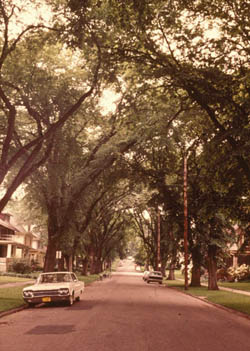Avoiding Monocultures | |
|---|---|
| September 26, 2007 | |
|
A monoculture is a planting of one species in a large area. As I look out the window of the Plant Clinic, I see monocultures of corn and soybeans. It is both efficient and productive to grow monocultures of a crop that is seasonal and of high value. On the other hand, use of monocultures comes with risk. If a pathogen, insect, or environmental stress becomes a problem, the entire planting is threatened. Southern corn leaf blight was devastating to corn in the 1970s. We have also seen problems in Illinois landscapes, such as the death of most elms from Dutch elm disease in the 1950s or losses from chestnut blight in the early 1900s. The image shows a monoculture of elms planted along a street in the 1950s. Rotation of crops is one method of avoiding some risk associated with monoculture. A year of corn production is followed by a year of soybeans, then corn, then soybeans, to avoid many disease and insect problems. This method works with many vegetables, annuals, and even some perenniels. Rotation, however, is not possible with established trees. Many municipalities have guidelines for planting trees—guidelines for diversity. Bill Vander Weit, city arborist in Champaign, Illinois, states that many cities use a tree-planting guideline that states: no more than 10% of a single species, no more than 20% of any genus, and no more than 30% of any tree family. These percents indicate city totals. This diversity guideline is used by the Champaign foresters, but it is only a guideline. Vander Weit explains that other considerations may make these guidelines impractical. For those interested in this issue, he recommends a paper by Norman A, Richards, “Reasonable Guidelines for Street Tree Diversity,” Journal of Arboriculture, 19(6): November 1993. Dr. Richards makes the point that city trees are often selected for their adaptation to the target site. Imposing strict planting percents may result in planting species that are not as well adapted to that site. Vander Weit said that his foresters would like to adhere to the guidelines but are sometimes hindered by tree availability. It is not always possible to obtain a wide range of species when needed. A point in case is the current situation with emerald ash borer. There is a very high percentage of ash species in most Illinois communities. This species adapts better than most to disturbed soils typical of new subdivisions. With the loss of ash as a choice, other less adaptable species will be planted. Before becoming too critical of overuse of some trees, consider a few other concerns as stated here and in Richards’s journal article. |
